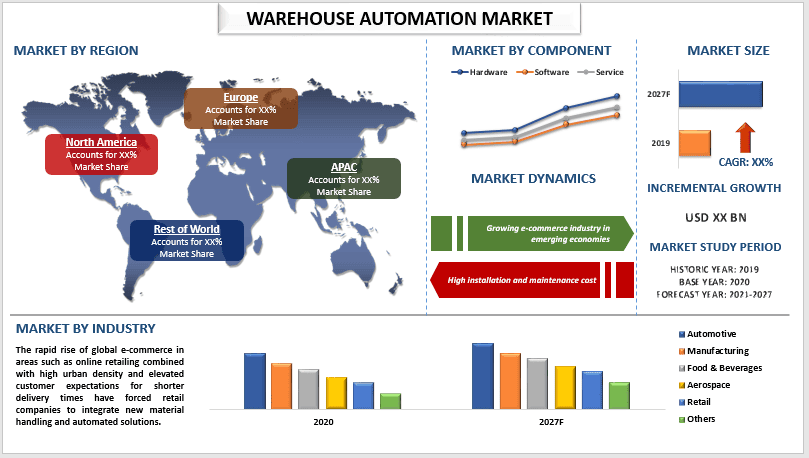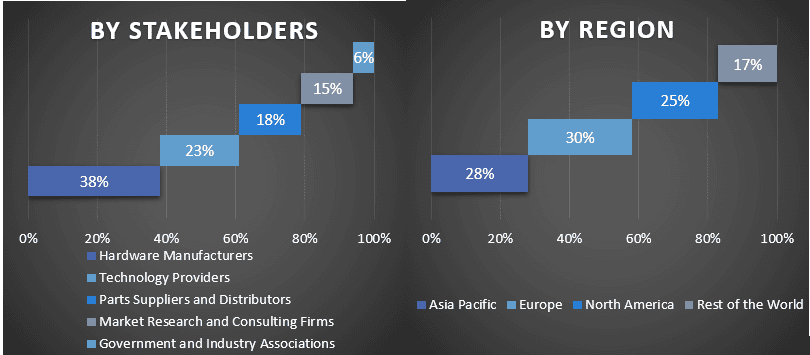Рынок автоматизации складов: текущий анализ и прогноз (2021-2027)
Акцент на компонентах (аппаратное обеспечение {мобильные роботы, автоматизированные системы хранения и поиска, системы электронной пакетировки/паллетирования и прочее}, программное обеспечение и услуги); отраслях (автомобилестроение, производство, продукты питания и напитки, аэрокосмическая промышленность, розничная торговля и прочие); и регионе/стране

ЗАПРОСИТЬ БЕСПЛАТНЫЙ ОБРАЗЕЦ PDF
Ожидается, что мировой рынок автоматизации складских помещений будет демонстрировать экспоненциальный среднегодовой темп роста (CAGR) ~12% в течение прогнозируемого периода (2021–2027 гг.). Это в основном связано с растущим вниманием предприятий к промышленной автоматизации и повышением безопасности на рабочем месте в сочетании со значительным ростом присутствия огромного сектора интралогистики в странах с развивающейся экономикой. Эти системы обеспечивают эффективное и экономичное перемещение продуктов и материалов в пределах заданных безопасных параметров, что делает их идеальными для использования на складах в любом случае, когда критически важны повторяющиеся и эффективные по времени операции. Складские роботы могут помочь компаниям электронной коммерции достичь своих целей по более быстрой доставке без ущерба для качества упаковки. Поскольку индустрия электронной коммерции и производства растет значительными темпами, ожидается, что рынок автоматизации складов также будет расти высокими темпами. Кроме того, основные игроки на рынке сосредотачиваются на запуске новых и передовых продуктов для повышения скорости и точности доставки для организаций, интегрирующих системы на своих предприятиях.
COVID-19 замедлил общий рост различных отраслей, включая обрабатывающую промышленность и автомобилестроение, а также нарушил цепочку поставок и сектор логистики в разных регионах. Страны были вынуждены ввести карантин в первой половине 2020 года. Обрабатывающая промышленность столкнулась со значительным падением доходов и прибылей в результате пандемии COVID-19. В бизнес-операциях произошло значительное сокращение рабочей силы, что привело к общему снижению производственной активности. Однако, чтобы справиться с проблемами ограниченной рабочей силы в условиях карантина и снизить вероятность передачи COVID-19 в трудоемких отраслях, основные заинтересованные стороны в экосистеме начали интегрировать системы и решения для технологий автоматизации на складах, чтобы повысить операционную эффективность и достичь своих соответствующих целей роста.
Daifuku Co. Ltd., JBT Corporation, KION GROUP AG, Jungheinrich AG, KNAPP Group, Toyota Industries Corporation, KUKA AG, Oceaneering International Inc., Fritz SCHÄFER GmbH & Co KG и Scott Technology Limited — вот некоторые из ключевых игроков на рынке. Этими игроками был предпринят ряд стратегических мер для предоставления клиентам высокотехнологичных и инновационных продуктов/технологий.
ЗАПРОСИТЬ ИНДИВИДУАЛЬНУЮ НАСТРОЙКУ
Выводы, представленные в отчете
«Среди компонентов категория оборудования занимала значительную долю рынка в 2020 году»
На основе компонентов рынок был разделен на оборудование, программное обеспечение и услуги. Среди них категория оборудования занимала значительную долю рынка в 2020 году, и ожидается, что она продемонстрирует устойчивый рост в течение прогнозируемого периода. Это в основном связано с растущим внедрением AMR. Растущее предпочтение торговым платформам электронной коммерции и растущая потребность в повышении эффективности складов привели к тому, что компании сосредоточились на автоматизации операций. Кроме того, на рост сегмента влияют такие факторы, как растущий спрос на автоматизированные склады и автоматизированное оборудование для обработки материалов в сочетании с гибкостью этих аппаратных систем и широким спектром задач, которые они могут выполнять.
«Ожидается, что среди отраслей розничная торговля продемонстрирует самый высокий среднегодовой темп роста в течение прогнозируемого периода»
На основе отраслей рынок классифицируется на автомобильную, обрабатывающую промышленность, производство продуктов питания и напитков, аэрокосмическую промышленность, розничную торговлю и другие отрасли. Среди них ожидается, что розничная торговля продемонстрирует самый высокий среднегодовой темп роста в течение прогнозируемого периода. Быстрый рост мировой электронной коммерции в таких областях, как онлайн-торговля, в сочетании с высокой плотностью городов и повышенными ожиданиями клиентов в отношении более коротких сроков доставки вынудили розничные компании интегрировать новые решения для обработки материалов и автоматизации. Мобильные роботы и автоматизированная система хранения и поиска — это решения для автоматизации, которые облегчают растущее давление, которое испытывают онлайн-ритейлеры, чтобы более эффективно отправлять заказы клиентам при одновременном снижении затрат на выполнение заказов.
«Ожидается, что в Азиатско-Тихоокеанском регионе будет наблюдаться значительный рост в течение прогнозируемого периода»
В 2020 году Азиатско-Тихоокеанский регион занимал прибыльную долю рынка благодаря быстрому росту секторов электронной коммерции, здравоохранения и логистики в странах с развивающейся экономикой, таких как Китай и Индия. Например, в Индии рост отрасли был вызван увеличением проникновения Интернета и смартфонов. Число подключений к Интернету в 2021 году значительно увеличилось и достигло 830 миллионов.
В 2020 году Китай занимал самую большую долю доходов на рынке автоматизации складов в Азиатско-Тихоокеанском регионе. Это можно объяснить ускоренной индустриализацией и увеличением расходов на передовые и автоматизированные решения в стране. Кроме того, в связи с быстрым ростом перерабатывающих отраслей, таких как электронная коммерция и логистика, а также ростом стоимости земли, труда и сырья, складская промышленность в Китае претерпевает существенный переход к автоматизированному оборудованию для повышения эффективности и управления возросшей рабочей нагрузкой. Кроме того, крупные инвесторы и венчурные капиталисты вкладывают значительные средства в новые стартапы, разрабатывающие роботов и AGV в стране. Например, в апреле 2022 года пекинская компания J-Elephant Technology Co. Ltd., производитель мобильных роботов в Китае, объявила о привлечении около 15 миллионов долларов США (100 миллионов китайских юаней) в рамках начального и предварительного раундов финансирования. В начальном раунде приняли совместное участие Sequoia China Seed Fund, Legend Star и Sinovation Ventures.
Причины купить этот отчет:
- Исследование включает анализ размера рынка и прогнозирования, подтвержденный признанными экспертами отрасли.
- Отчет представляет собой краткий обзор общих показателей отрасли с первого взгляда.
- Отчет охватывает углубленный анализ видных коллег по отрасли с основным упором на ключевые финансовые показатели бизнеса, портфель продуктов, стратегии расширения и последние разработки.
- Подробное изучение движущих сил, ограничений, ключевых тенденций и возможностей, преобладающих в отрасли.
- Исследование всесторонне охватывает рынок по различным сегментам.
- Глубокий анализ отрасли на региональном уровне.
Варианты настройки:
Мировой рынок автоматизации складов может быть дополнительно настроен в соответствии с требованиями или любым другим сегментом рынка. Кроме того, UMI понимает, что у вас могут быть свои собственные бизнес-потребности, поэтому не стесняйтесь обращаться к нам, чтобы получить отчет, который полностью соответствует вашим требованиям.
Содержание
Методология исследования для анализа глобального рынка автоматизации складов (2021-2027 гг.)
Анализ исторического рынка, оценка текущего рынка и прогнозирование будущего рынка глобального рынка автоматизации складов были тремя основными этапами, предпринятыми для создания и анализа внедрения автоматизации складов в основных регионах мира. Было проведено исчерпывающее вторичное исследование для сбора исторических данных о рынке и оценки текущего размера рынка. Во-вторых, для подтверждения этих выводов было принято во внимание множество результатов и предположений. Кроме того, были проведены исчерпывающие первичные интервью с отраслевыми экспертами по всей цепочке создания стоимости глобального рынка автоматизации складов. После предположений и подтверждения рыночных данных посредством первичных интервью мы применили нисходящий/восходящий подход к прогнозированию полного размера рынка. После этого были приняты методы разбивки рынка и триангуляции данных для оценки и анализа размера рынка сегментов и подсегментов отрасли. Подробная методология описана ниже:
Подробнее о методологии исследования
Анализ исторического размера рынка
Этап 1: Углубленное изучение вторичных источников:
Было проведено подробное вторичное исследование для получения исторических данных о размере рынка автоматизации складов из внутренних источников компании, таких как годовые отчеты и финансовые отчеты, презентации о деятельности, пресс-релизы и т. д., и внешних источников, включая журналы, новости и статьи, правительственные публикации, публикации конкурентов, отраслевые отчеты, сторонние базы данных и другие надежные публикации.
Этап 2: Сегментация рынка:
После получения исторических данных о размере рынка автоматизации складов мы провели подробный вторичный анализ для сбора исторических данных о рынке и доли различных сегментов и подсегментов для основных регионов. Основные сегменты, включенные в отчет, включают компоненты и отрасли. Дальнейший анализ на уровне стран был проведен для оценки общего внедрения моделей тестирования в этом регионе.
Этап 3: Факторный анализ:
После получения исторических данных о размере рынка различных сегментов и подсегментов мы провели подробный факторный анализ для оценки текущего размера рынка автоматизации складов. Кроме того, мы провели факторный анализ с использованием зависимых и независимых переменных, таких как компоненты и отрасли автоматизации складов. Был проведен тщательный анализ сценариев спроса и предложения с учетом ведущих партнерств, слияний и поглощений, расширения бизнеса и запуска продуктов в секторе рынка автоматизации складов по всему миру.
ЗАПРОСИТЬ ИНДИВИДУАЛЬНУЮ НАСТРОЙКУ
Оценка текущего размера рынка и прогноз
Оценка текущего размера рынка: Основываясь на действенных выводах, полученных на основе вышеуказанных 3 этапов, мы пришли к текущему размеру рынка, ключевым игрокам на глобальном рынке автоматизации складов и долям рынка сегментов. Все необходимые процентные доли и разбивки рынка были определены с использованием вышеупомянутого вторичного подхода и были проверены посредством первичных интервью.
Оценка и прогнозирование: Для оценки и прогнозирования рынка различным факторам были присвоены веса, включая драйверы и тенденции, ограничения и возможности, доступные для заинтересованных сторон. После анализа этих факторов были применены соответствующие методы прогнозирования, т. е. нисходящий/восходящий подход, чтобы получить прогноз рынка примерно на 2027 год для различных сегментов и подсегментов на основных рынках мира. Методология исследования, принятая для оценки размера рынка, включает в себя:
- Размер рынка отрасли с точки зрения выручки (в долларах США) и уровень внедрения рынка автоматизации складов на основных рынках внутри страны
- Все процентные доли, разбивки и разбивки рыночных сегментов и подсегментов
- Ключевые игроки на глобальном рынке автоматизации складов с точки зрения предлагаемых решений. Кроме того, стратегии роста, принятые этими игроками для конкуренции на быстрорастущем рынке
Подтверждение размера рынка и доли
Первичное исследование: Были проведены углубленные интервью с ключевыми лидерами общественного мнения (KOL), включая руководителей высшего звена (CXO/VPs, руководители отделов продаж, руководители отделов маркетинга, руководители операционных отделов, региональные руководители, руководители стран и т. д.) в основных регионах. Затем были обобщены результаты первичного исследования и проведен статистический анализ для подтверждения заявленной гипотезы. Результаты первичного исследования были объединены с результатами вторичного исследования, что превратило информацию в полезные выводы.
Разбивка первичных участников по различным регионам

Инжиниринг рынка
Метод триангуляции данных был использован для завершения общей оценки рынка и получения точных статистических данных по каждому сегменту и подсегменту глобального рынка автоматизации складов. Данные были разделены на несколько сегментов и подсегментов после изучения различных параметров и тенденций в областях компонентов и отраслей на глобальном рынке автоматизации складов.
Основная цель исследования глобального рынка автоматизации складов
В исследовании была точно определена текущая и будущая рыночная тенденция на глобальном рынке автоматизации складов. Инвесторы могут получить стратегические сведения, чтобы основывать свои решения об инвестициях на качественном и количественном анализе, выполненном в исследовании. Текущие и будущие рыночные тенденции определили общую привлекательность рынка на региональном уровне, предоставив промышленному участнику платформу для использования неиспользованного рынка для получения выгоды в качестве преимущества первопроходца. Другие количественные цели исследований включают:
- Анализ текущего и прогнозируемого размера рынка автоматизации складов в стоимостном выражении (в долларах США). Кроме того, анализ текущего и прогнозируемого размера рынка различных сегментов и подсегментов
- Сегменты исследования включают области компонентов и отрасли.
- Определение и анализ нормативно-правовой базы для отрасли рынка автоматизации складов.
- Анализ цепочки создания стоимости с участием различных посредников, а также анализ поведения клиентов и конкурентов в отрасли.
- Анализ текущего и прогнозируемого размера рынка автоматизации складов для основного региона.
- Основные страны регионов, изученные в отчете, включают Азиатско-Тихоокеанский регион, Европу, Северную Америку и остальной мир.
- Профили компаний рынка автоматизации складов и стратегии роста, принятые участниками рынка для поддержания устойчивости на быстрорастущем рынке
- Углубленный анализ отрасли на региональном уровне
Связанные Отчеты
Клиенты, купившие этот товар, также купили










